Statistics around how EDA is trending globally
Event-driven architecture is a software design pattern in which decoupled applications can asynchronously publish and subscribe to events via an event broker (modern messaging-oriented-middleware).
According to a Solace-commissioned survey of 840 people in 9 countries across the globe, 85% of organizations have turned to event-driven architecture to meet their business needs.
For many, event-driven architecture has already proven its value, the benefits by far outweighing the costs, and they are on the way to implementing it across a variety of use cases in their organizations.
Here’s a summary of what you’ll find on this page, which include a variety of statistics concluded from the survey:
- Key Event-Driven Architecture Stats
- Why Do Organizations Adopt Event-Driven Architecture?
- What Business Issues Does Event-Driven Architecture Help Solve?
- Cost vs Benefits of Event-Driven Architecture
- Consequences of Not Using Event-Driven Architecture
- Stats on the Global Usage of Event-Driven Architecture
- Business Challenges in Adopting Event-Driven Architecture
- Stakeholder Buy-in – The Gap Between Business and IT
- 5 Keys to Event-Driven Architecture Implementation
- Survey Methodology and Parameters
Key Event-Driven Architecture Stats
- Event-driven architecture is in widespread use for 72% of global businesses.
- Only 13% of organizations have reached the gold standard of event-driven architecture maturity, where it has been applied throughout the organization for most use cases.
- Looking at the advantages of event-driven distribution, 71% of organizations see benefits outweighing the costs, or at least equaling them.
- Financial services, telecoms, and media and technology companies are at the forefront of the adoption wave, with 27% of organizations having a central team promoting it within the organization.
- For those that have successfully implemented event-driven architecture, 94% stated they would consider applying it to further use cases in their organizations.
- While the majority of organizations believe in the benefits of event-driven architecture, 27% of organizations are not in a position to direct resources to implement it.
- Only 35% of people in business roles understand appreciate the value of real-time event-driven data distribution.
Why Do Organizations Use Event-Driven Architecture?
There are two main reasons businesses are looking to invest in event-driven architecture: its real-time capabilities, which allows them to react faster and more efficiently to a fast-paced business environment, and its decoupled nature, which grants the ability to cope with unanticipated disruptions.
In the face of this dual imperative of handling disruption and innovating at speed to stay afloat, event-driven architecture enables the resiliency that businesses need.
The top three priorities for organizations adopting event-driven architecture are:
- Improving application responsiveness (latency, speed, etc.) – 46%
- Improving customer experiences – 44%
- Responding to events and changes in real-time and improving application resiliency and availability – 43%
The three most common applications of real-time data are:
- Application integration (56%),
- data sharing across applications (48%), and
- connecting IoT devices for data ingestion and/or analytics (45%).
These are all crucial as organizations face new demands such as sales spikes, burst handling, hybrid working, and the need to develop new services to keep their customers happy.
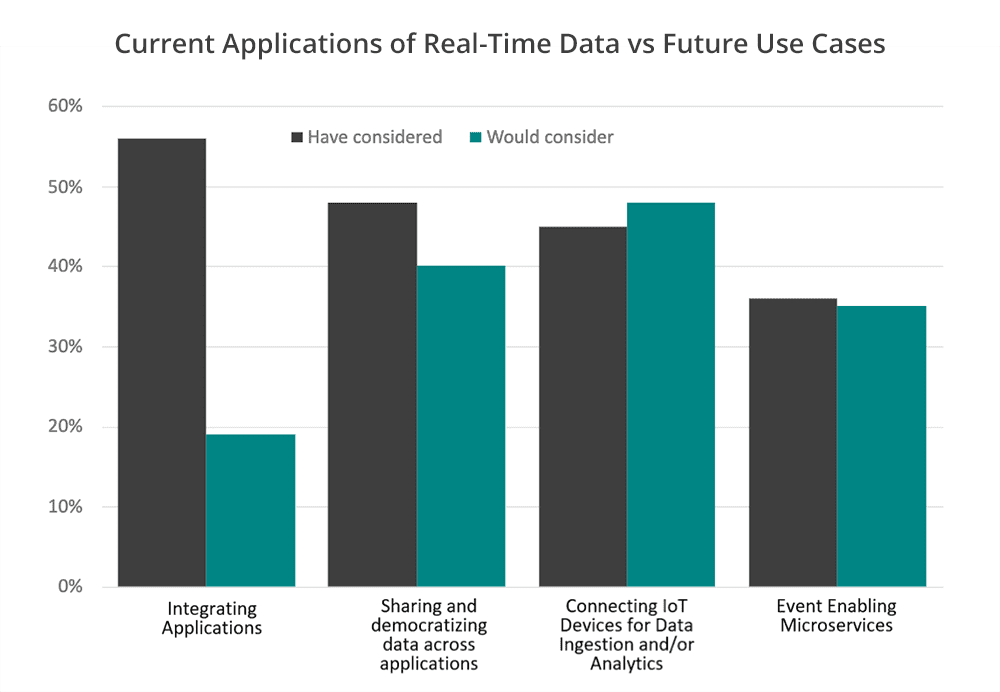
What Business Issues Does Event-Driven Architecture Solve?
In 2021, overcoming COVID-19 related issues, such as travel regulations and airport handling, is where 47% of organizations found event-driven architecture beneficial. This was considered a main priority for 52% of businesses in APAC and 52% in EMEA.
For North America, 50% of organizations believe that data governance and regulation is the area that will benefit the most by real-time data sharing. This is likely due to the lack of an overarching data law in the US, which increases businesses’ need to be able to react to local regulations.
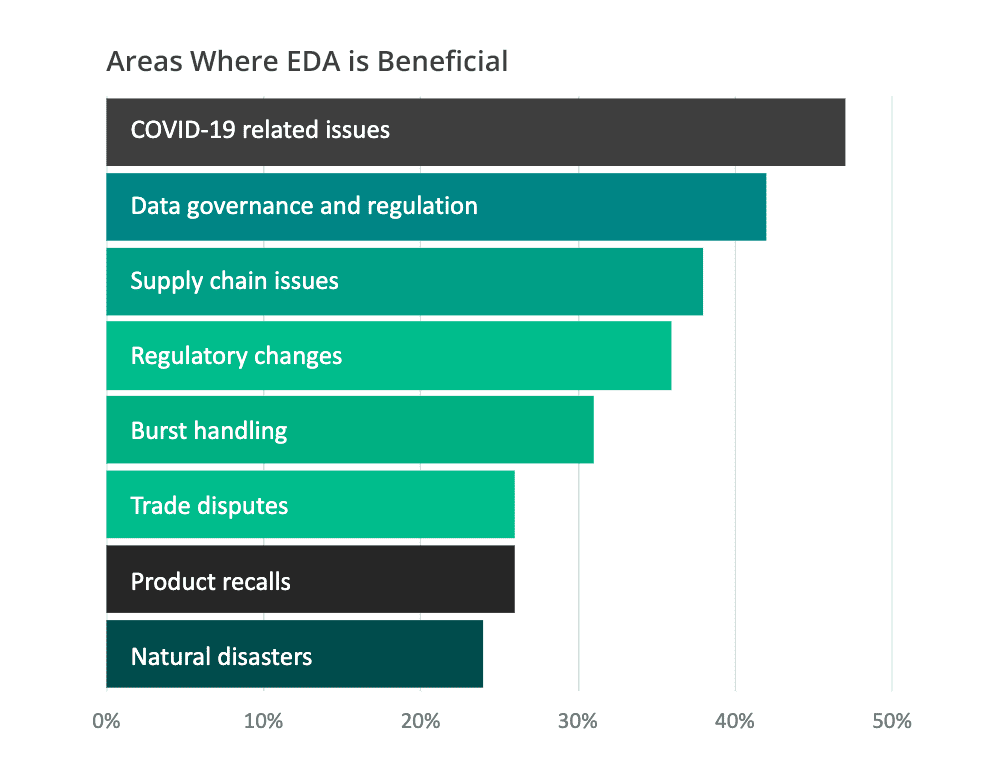
When looking at industries, the sectors that are keen to use event-driven architecture to combat issues brought on by COVID-19 – like creating more flexible supply chains to cope with lockdowns, and keeping employees safe with effective track-and-trace systems – are as follows:
- 57% of financial services companies
- 53% of retail and CPG organizations
- 47% in the transportation and logistics sector
- 46% in the government, technology, telecom, and media sectors.
Cost vs Benefits of Event-Driven Architecture
The main disadvantages of event-driven architecture that are often talked about are complexity and cost, but 71% of organizations believe the benefits of event-driven distribution outweigh, or at least equal, the costs.
Share this stat with your followers!Across the globe, over half of organizations have enthusiastically bought into the benefits of event-driven architecture. The UK (79%), Canada (79%) and France (73%) are the first ones to admit that the benefits outweigh or equal the costs.
Less than a third of companies (31%) point to costs as a main roadblock to implementation.
Sector-wise, 13% of government and public sector organizations struggle the most to understand how the costs and benefits correlate, over double the global figure of 6%.
Perhaps as a result of wholesale innovation due to COVID-19, 58% of the life sciences sector organizations believe the benefits outweigh the costs.
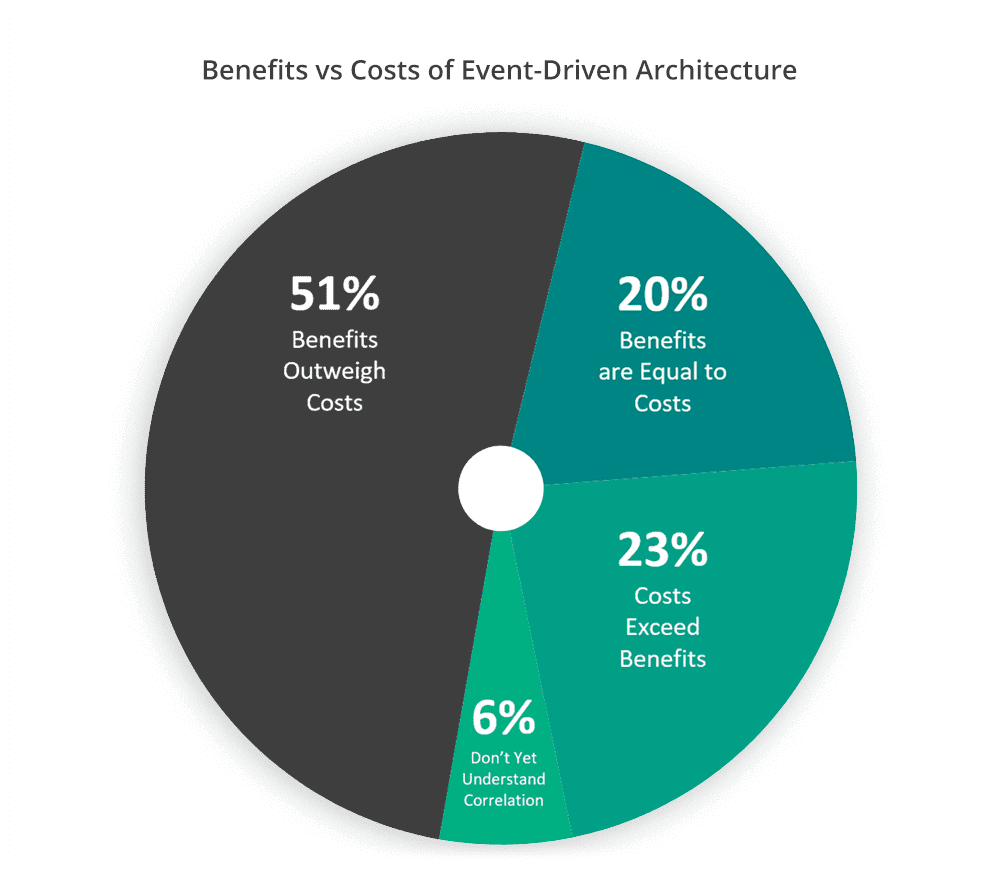
Consequences of Not Using Event-Driven Architecture
Beyond the inherent advantages of adopting event-driven architecture, businesses are equally keen to avoid the negative effects of lacking real-time event-driven data distribution. The consequences of making decisions with inaccurate or out of date information is something that concerns 46% of businesses.
The inability to respond quickly to threats and opportunities is something that concerns 45% of businesses. Without real-time response capabilities, businesses expose themselves to unnecessary risks, and miss out on potential big breaks.
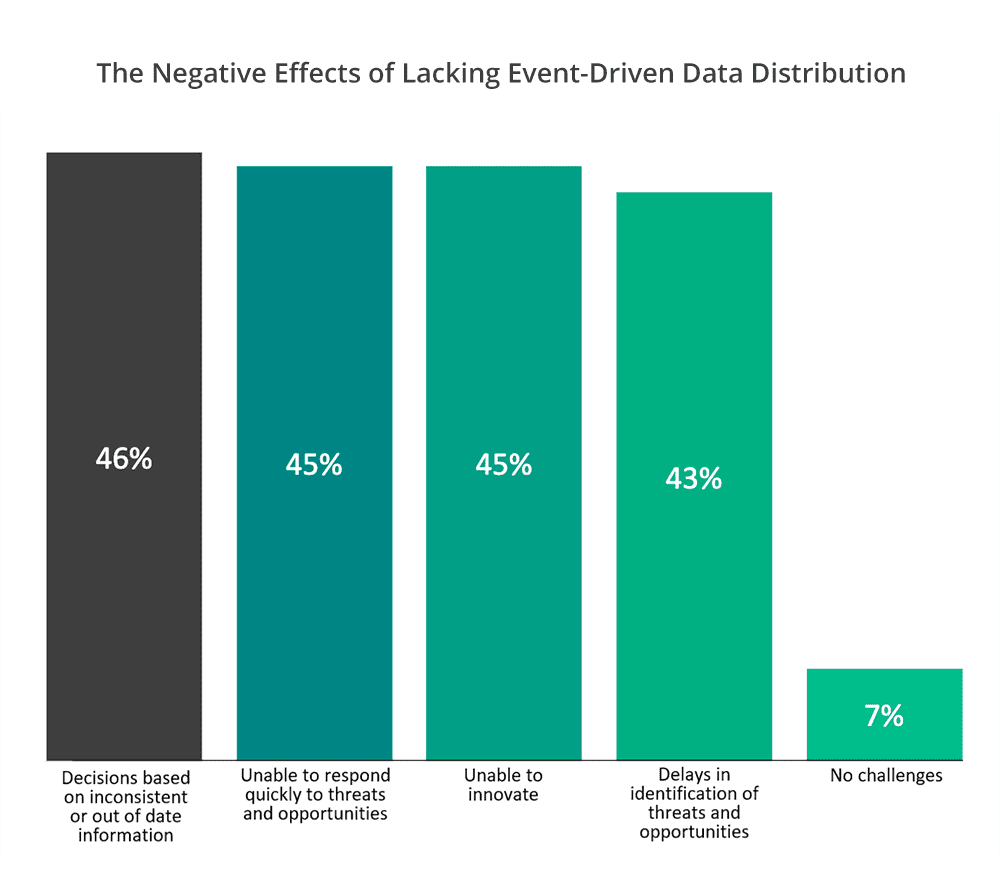
From an industry perspective, 57% of financial services organizations are particularly concerned with the issue of detecting and reacting to threats in a timely manner
The lack of real-time data leading to decisions made on inconsistent or outdated information concerns 46% of transportation and logistics businesses and 44% of retail businesses.
Globally, 7% of organizations believe that they have no challenges as a result of the lack of real-time data. That figure jumps to 13% in the life sciences sector and 16% in the government and public sector.
Stats on Global Usage of Event-Driven Architecture
As previously stated, event-driven architecture is in widespread use for 72% of global businesses, albeit at different levels of maturity.
The largest proportion, 23% of businesses, has already adopted event-driven architecture, with a central team promoting it, supporting a centralized event store/ecosystem, and often integrating it with API initiatives.
The fact that the largest proportion is at such an advanced level shows a growing wave of early adopters, with the rest following close:
- 19% have a central team promoting event-driven architecture and support a number of event distribution tools and use cases.
- 18% already have several instances of event-driven architecture across multiple use cases.
- 8% have no plans to look into event-driven architecture.
- 7% have these plans to adopt event-driven architecture but have made no progress yet.
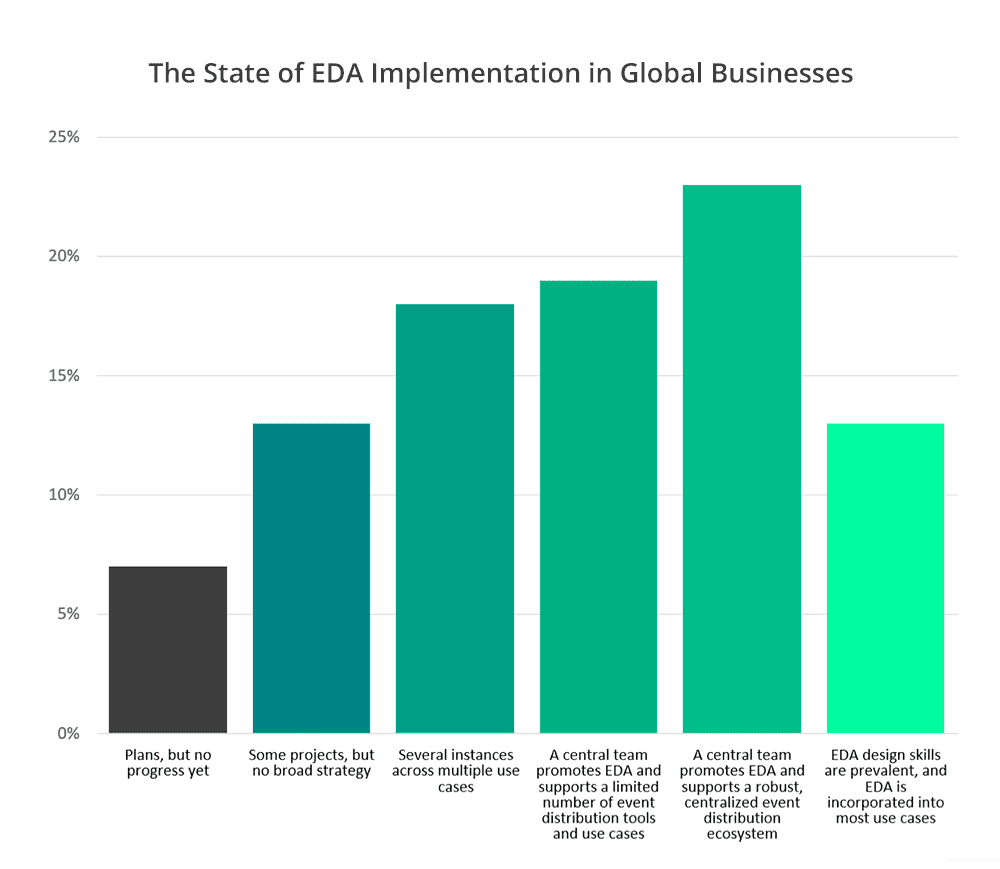
Business Challenges in Adopting Event-Driven Architecture
There are a number of challenges organizations must face on the way to achieving the goal if full implementation of event-driven architecture. The majority of organizations (75%) cite the lack of adequate technology to implement event-driven architecture as a roadblock, while others (59%) believe they haven’t yet identified the right tools and vendors to meet their needs.
Educating the company on the benefits of event-driven architecture is seen as a critical hurdle for 38% of businesses.
When broken down by company size, with respect to the number of employees:
- 41% of medium organizations (501 to 1,000 employees) desire more education on how event-driven architecture can solve their specific problems
- 39% of large organizations (1,000 – 5,000 employees) struggle to understand the benefits of applying it enterprise-wide.
- When considering how to implement event-driven architecture, 37% of companies feel they need to hire more talent with the necessary skills to guarantee success.
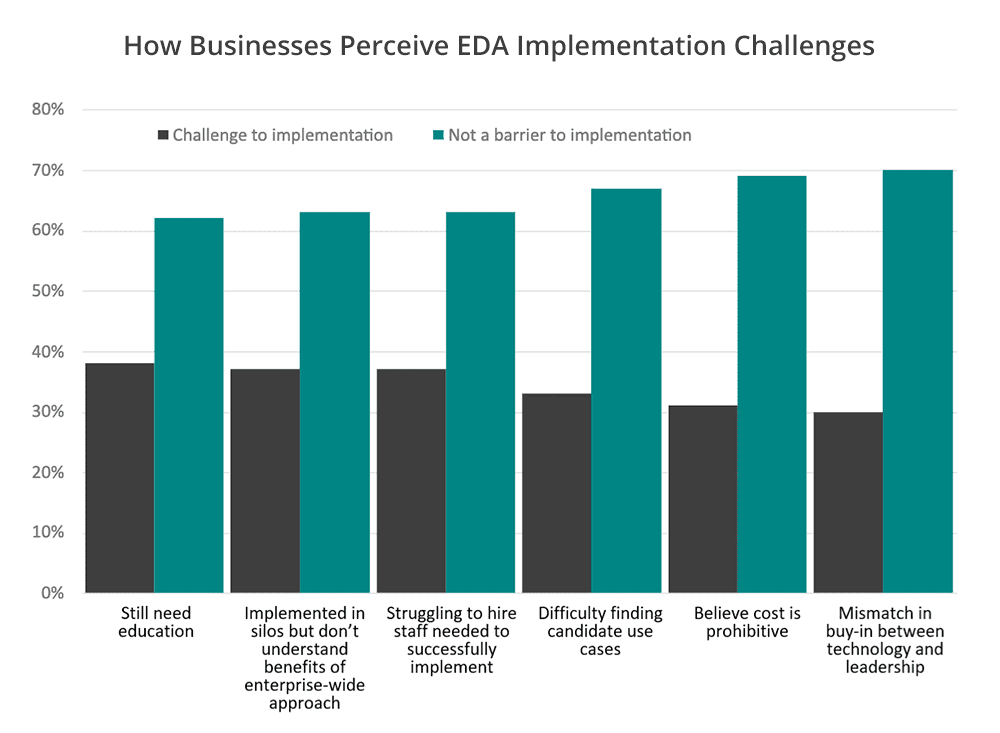
Three in ten organizations are affected by the mismatch in buy-in between the business and IT departments. This affects a uniform number of respondents across company sizes, except in the case of organizations with between 1,000 and 5,000 employees, where it is a struggle for 38% – over the total global average of 30%.
Stakeholder Buy-in – The Gap Between Business and IT
There is a is disconnect between IT and business when it comes to understanding business value of event-driven architecture. For event-driven architecture to succeed, it needs buy-in across the business.
On the IT side, 61% already appreciate the value of real-time event-driven data distribution. This is to be expected as IT jobs are the ones to be immediately aided and streamlined by event-driven architecture.
The number drops off to 35% when looking at business roles, where decision makers might have a harder time connecting the technology with the bottom line.
When the data is broken down into more specific roles in an organization, it looks like this:
- 62% of IT operations understand how real-time data can bring value to the organization.
- 60% of IT leadership know and support the benefits of event-driven architecture.
- 38% of senior and executive management appreciate the value of real-time data.
- 32% of line of business executives understand how the business bottom line can benefit from event-driven architecture.
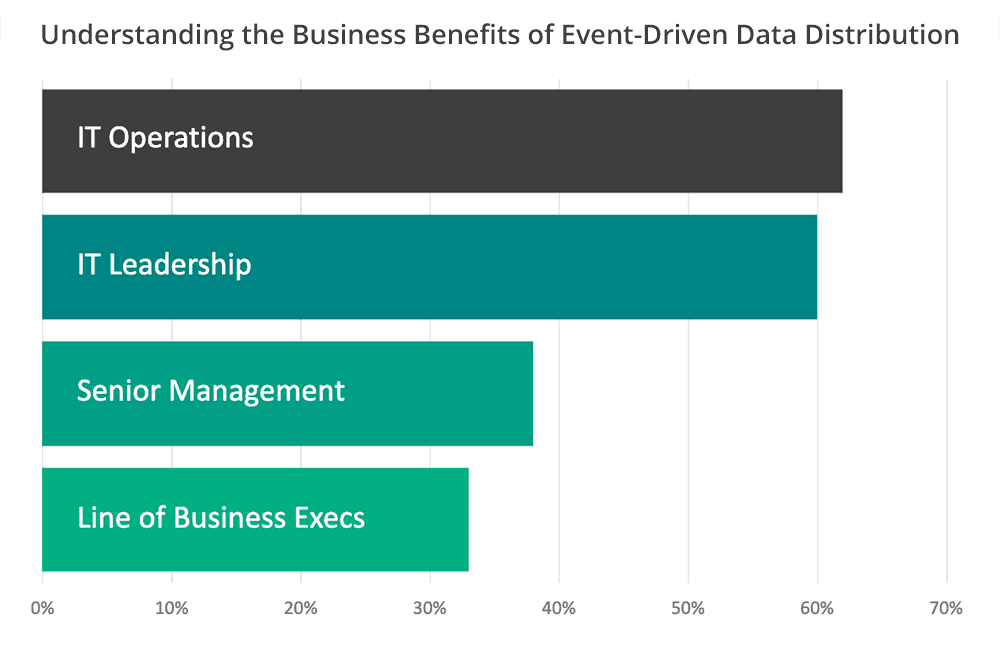
5 Keys to Event-Driven Architecture Implementation
These are the five most common keys to implementing event-driven architecture as identified by surveyed businesses:
- Identifying the right technology (75%)
- Identifying the right partner to help implement the chosen platform and tools (59%)
- Educating stakeholders across the organization about the benefits of enterprise-wide event-driven architecture (38%)
- Hiring people with the right skills for implementation (37%)
- Identifying a cost-effective solution (31%)
Conclusion
Event-driven architecture is experiencing strong growth across industries where real-time data distribution brings more obvious benefits (financial services, retail, telecom) but lagging a bit in the sectors that are not impacted as much by customer demands (government & public sector).
Despite seeing a spike in growth around the globe, the major roadblock seems to be the fact that business benefits are being lost in translation from IT groups to the business executives concerned the most with the bottom line.
The COVID-19 pandemic identified a lot of areas in business that needed improvement and that could benefit from event-driven architecture and access to real-time data. Many retailers and supply chain & logistics companies seized the opportunity to make changes to their IT infrastructure to combat the issues that were highlighted during lockdowns, labor shortages, and changing customer demands.
Only 13% of organizations have reached the promised land of enterprise-wide event-driven architecture adoption but it is in widespread use across more than 70% of organizations globally.
Here is a list of helpful resources if you’re considering event-driven architecture for your organization:
- Six + 1 Steps to Implement Event-Driven Architecture
- Case Study: Roche Drives Agility By Uniting Event-Driven Architecture And API-Led Integration As One
- Event-Driven Architecture Myth Busting — Part 1 & Part 2
- Gartner’s Advice on How to Choose an Event Broker
- Event-Driven Architecture Certification Path for Architects and Developers
- Comparing event streaming platforms and technologies for event-driven architecture
- A Guide for the Developer’s Journey to Event-Driven Development
Survey Methodology & Parameters
Solace commissioned independent research firm Coleman Parkes to lead a global survey on event-driven architecture (EDA) and help shed light on how organizations are striving to incorporate real-time data and EDA into their enterprise landscape.
Conducted in August 2021, the survey harvested 840 respondents in 9 countries across EMEA, North America, Australia, and Asia-Pacific, in roles ranging from C-Suite to IT architecture.
